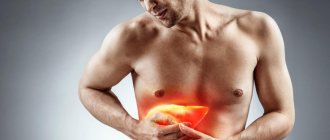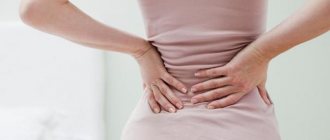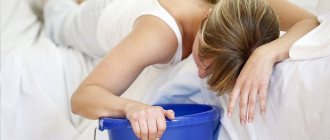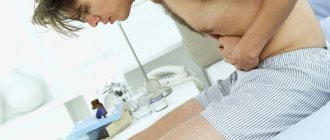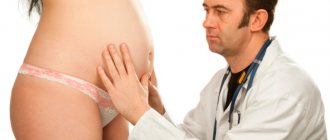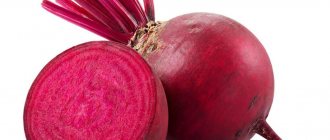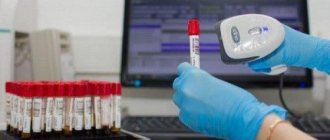The article was prepared by a specialist for informational purposes only. We urge you not to self-medicate. When the first symptoms appear, consult a doctor.
An unusual color of stool can alert a person who cares about their health and become a reason to consult a doctor. The first assumption when yellow stool appears is that there is a problem with the liver. The dark yellow color of feces usually does not bother you, but the light yellow color of feces is most often a sign of trouble in the gastrointestinal tract.
The normal composition of the solid fraction of feces is:
- 30% - undigested food;
- 30% - bacteria;
- 15% - inorganic substances;
- 15% - fats;
- 5% - protein.
The color of stool depends on the number of bacteria present in the human body at the time of stool formation.
Purchasing coloring
Normal - brown stool is caused by breakdown products of the bile pigment bilirubin. When excreted with bile into the small intestine, it is partially converted into colorless urobilinogen, and then in the large intestine through the stercobilinogen stage it becomes brown stercobilin. Another stool-coloring product of bilirubin metabolism is called mesobilifuscin. If the stool turns yellow, it indicates problems with digesting food and separating bile. Sometimes color changes are considered normal and occur due to dietary habits, under the influence of medications, and at certain periods of a person’s life.
Diseases in which stool becomes lighter in color
The food taken in is colored dark brown by stercobilin; it is a derivative of bilirubin, which is responsible for the breakdown of fats. If the ratio of the amount of food, fat in it and bilirubin produced for its breakdown is normal, then the color of the stool should not be yellow. Most likely, this shade appears due to the fact that not all fats are processed. Violations:
- gastrointestinal disorder;
- viral disease;
- hormonal disorder in women (pregnancy, PMS, menopause);
- psychological disorder.
Many chronic diseases mean possible yellow stools. These are diabetes mellitus, gastritis, pyelonephritis, pancreatitis.
A light diet will help quickly restore stool, but you need to tell your doctor about this.
Gastrointestinal disorder
In this case, not only the color of the feces changes, but also its consistency. This is very liquid stool.
Effect of diet and medications
One of the reasons for the normal change in the color of feces can be seen in the example of a newborn child: during the first period of life, children feed exclusively on mother's milk, which leads to a yellow color of their discharge. Both this color and the mushy consistency of stool are natural for a baby. An adult can expect a similar change if there is too much milk or fermented milk products in his diet. Yellowing of stool can also be caused by:
- carrot;
- sweet potato;
- turmeric;
- oranges;
- persimmon;
- melon;
- dried apricots;
- apples;
- pears;
- peas.
A large amount of such food causes changes due to natural dyes. The frequency of visits to the toilet and the consistency of stool remain normal. The effect wears off quickly and can be tracked by your daily diet.
Feces may also turn yellow due to side effects of medications: especially if they cause indigestion, dysbacteriosis, or affect liver function. Examples of such drugs are contraceptives based on estrogen derivatives, drugs for tuberculosis, gout, cytostatics, non-steroidal anti-inflammatory drugs, and laxatives. The list includes:
- Methotrexate;
- Cyclophosphamide;
- Isoniazid;
- Streptomycin;
- Ethambutol;
- Paracetamol;
- Diclofenac;
- Aspirin;
- Allopurinol.
The yellow color of stool often indicates that it is being eliminated from the body too quickly. Bilirubin simply does not have time to turn into stercobilin. This phenomenon often accompanies diarrhea.
Why does stool turn orange?
Orange-colored feces are not always a cause for concern. Stercobilin is a pigment that colors feces, but in addition to it, the color is affected by a person’s diet, individual characteristics and the use of certain medications. Mono-diets with foods that contain beta-carotene are another reason for orange-colored stool. These include carrots with pumpkin, cauliflower, sweet potatoes, sea buckthorn oil and others. Beta-carotene is not completely absorbed in the body, a maximum of 40 percent. This part is converted into vitamin A, and whatever remains is excreted from the body.
In addition to the foods described above, beta-carotenes (coloring pigments) are also found in the following foods: pumpkin, sea buckthorn oil, sweet potatoes, some salads, spinach and various herbs. The dye is not completely digested by the body, about 30%, since it has a fibrous structure. After the pigment has passed through the intestines, it is gradually converted into vitamin A. The amount of dye that the stomach digests directly depends on the amount of gastric juice (bile) in the body. Thus, children absorb beta-carotenes in a smaller amount than adults. The remaining 70% of the pigment is excreted through urine and feces, simultaneously coloring them orange.
An overdose of vitamin A causes a person to have loose, orange-colored stools.
Some multivitamins that contain carotene also contribute to a change in stool color if taken for a long period of time. Patients may notice yellowing of the skin on the palms and feet, and a change in the color of the whites of the eyes. The stool turns orange if the patient takes the drug Rifampin to treat tuberculosis. Drugs such as Nifuroxazide and Furazolidone can also give an orange color to feces.
How to understand whether a change in stool color is a consequence of a change in diet and the use of new medications, or is there another reason? You just need to stop eating foods with unsaturated carbohydrates and suspend the course of treatment with multivitamins or Rifampicin for three days. If the color of the feces remains the same, then we can conclude that the problem lies elsewhere.
Special conditions and hereditary diseases
Yellow feces can accompany disorders of the digestive tract associated with nervous tension, stress, and depression. In women, it can appear during the premenstrual period, during menopause, and during pregnancy. This is due to both hormonal changes and changes in the functioning of the digestive organs: for example, during compression and displacement by the growing uterus.
If you overeat, some of the food that enters the body may not be digested, which will affect the color of the stool.
Yellow stools are a common occurrence when bilirubin metabolism is impaired due to hereditary diseases. Thus, with Gilbert's syndrome, the patient's microsomal liver enzymes do not work well, and bilirubin is deposited in the tissues and gives them a yellow tint. The feces also become yellow or grayish-white, the person quickly gets tired, has trouble digesting food, and suffers from belching and nausea.
Hereditary pathologies also include celiac disease - gluten intolerance. The intestinal mucosa in such patients is inflamed, gluten is broken down and poorly absorbed, and diarrhea begins after eating rye products, food with wheat, and barley. Gliadin from gluten accumulates in the intestines and poisons its cells, which in celiac disease become hypersensitive to it. Due to poor absorption of nutrients, patients lose weight, and diarrhea dehydrates them and leads to vitamin deficiency.
Causes of yellow diarrhea
The following diseases and conditions can be the causes of bright yellow or mustard-colored loose stools.
Intestinal infection
. The causative agents of intestinal infectious diseases can be viruses (for enterovirus, rotavirus infections, etc.), bacteria (for cholera, salmonellosis, dysentery), bacterial toxins (for toxic infections), as well as fungi and protozoa. They enter the body along with contaminated food, water, or when personal hygiene requirements are not observed. Also, the source may be poorly washed or long-stored food, toys, household items, and food products that have not undergone heat treatment. The disease can develop rapidly and be quite severe (frequent urge and loose stools quickly lead to dehydration and other complications).
Food poisoning.
It can occur when eating inedible or poisonous mushrooms or spoiled dishes. If products (especially fermented milk) are stored improperly and sanitary requirements are not observed during the preparation of various dishes, staphylococcus, E. coli and other pathogenic microorganisms can multiply in them. During their life activity, pathogenic microorganisms release many toxins, which poison the human body when they enter it with contaminated food.
Food allergies
. Food allergies are often accompanied by digestive disorders. Manifestations of such a reaction in a child or adult from the gastrointestinal tract may include pale yellow diarrhea, severe flatulence, nausea, etc.
Other reasons.
Light yellow diarrhea can be observed with problems with the gastrointestinal tract, including the liver and gall bladder, and pancreatic enzymatic insufficiency. It also appears with excessive consumption of dairy products, especially if a person suffers from lactose intolerance. Also, such stools sometimes occur in infants whose diet consists primarily of breast milk or formula.
Pathologies and examinations
Many diseases of the gastrointestinal tract develop gradually, therefore, if the stool is yellow in an adult, its causes may be hidden in inflammatory lesions of the pancreas, liver, and gallbladder. Bacterial, viral and parasitic infections are more active: they are often accompanied by signs of general intoxication, develop quickly and can be cured just as quickly. The first conclusions about the causes can be made based on the sum of the symptoms: the patient needs to pay attention to the pain, the area of its occurrence, the conditions for the appearance of yellow feces and general well-being.
| Disease | Features of feces | Other symptoms | Diagnostics |
| Escherisiosis | Liquid, golden yellow, 10-15 times a day, may contain mucus and blood | Weakness, headache, fever, chills, pain around the navel | Stool culture for bacteria, blood and urine tests |
| Salmonellosis | Greenish-yellow, foamy, watery, foul-smelling, later may contain mucus and blood | High fever, pain in the head, muscles, upper abdomen and umbilical area, nausea, vomiting, pale skin, dry tongue, bloating | Culture of vomit or feces for Salmonella, ELISA (enzyme-linked immunosorbent assay) |
| Rotavirus infection | Light yellow in color, 5-15 times a day, with a sour odor, may be foamy | Nausea, vomiting on the first day, abdominal pain, fever | Antigen search in stool by PCR (polymerase chain reaction), RLA (latex agglutination) |
| Enterovirus infection | May be foamy | Prolonged fever, weakness, headache, muscle pain, nausea, rashes, red throat, grittiness | Detection of antibodies in the blood using the RSK (compliment fixation reaction) and HRI (hemagglutination inhibition reaction) methods. |
| Giardiasis | Bright yellow, liquid, foul-smelling, 5-7 times a day, foamy, greasy | Dull pain in the right hypochondrium, nausea, flatulence | Biochemical blood test, search for pathogens in feces and intestinal contents, ELISA, PCR |
| Pancreatitis | Light yellow or grayish | In acute cases - pain in the left hypochondrium, which can be encircling and radiate to the scapula, vomiting, yellowing of the sclera, increased temperature | General and biochemical blood test, urine test, ultrasound, MRI |
| Hepatitis | Light yellow, clay white | Yellowing of the integument, eyes, dark urine, itching, red dots on the body, fatigue, pain in the right hypochondrium, redness of the palms, bleeding and a tendency to bruise | Blood test, ultrasound, liver biopsy |
| Chronic cholecystitis | Light yellow, mushy | Moderate dull pain in the right hypochondrium, radiating to the right shoulder or shoulder blade. Nausea, bitterness in the mouth | General and biochemical blood test, ultrasound of the gallbladder, duodenal intubation, x-ray examination |
| Cholelithiasis | Yellow or grayish white | Acute sudden pain in the right hypochondrium, radiating to the right shoulder, shoulder blade, neck, back. Nausea, vomiting, fever | General and biochemical blood test, cholecystography, ultrasound, MRI |
| Celiac disease | Light yellow, pungent odor, liquid, foamy, with undigested food | Decreased performance, weight loss, rumbling in the stomach, flatulence | Blood test for antibodies to gliadin and tissue transglutaminase, small intestinal biopsy, ultrasound, MRI, contrast fluoroscopy |
Tests help confirm the diagnosis or detect other pathologies. Using blood tests, you can check the activity of the pancreas and liver function, and detect antibodies that are produced in the body in response to the invasion of parasites. They look for protozoa in feces, intestinal contents, and vomit, and do cultures to look for harmful bacteria. The condition of internal organs can be more accurately determined using complex examination methods.
- Ultrasound
helps to notice inflammation and proliferation of connective tissue using ultrasound. - Radiography
- search for inflammation and formations using x-rays. Cholecystography is the study of the gallbladder. - Duodenal intubation
is the collection of bile from the duodenum using a probe. - MRI
- magnetic resonance imaging, a detailed study of internal organs by measuring the electromagnetic response of atomic nuclei.
Other colors of stool also indicate changes. So, green stool is possible when eating lettuce and vegetables, dysbacteriosis. Grayish-white - with hepatitis, taking barium sulfate during radiography. Red may indicate bleeding in the lower intestines, while black may indicate bleeding in the stomach or small intestine.
Infections and parasitic infestations
Bacteria, viruses and protozoa enter the human body through unwashed hands, contaminated products, or through contact with patients, their objects, or pets. Having settled in the intestines, they disrupt the digestion process, poison the body with waste products, and weaken the patient. Yellow feces often occur with escherichiosis and salmonellosis. In the first case, the culprit of the infection is E. coli, in the second - salmonella. With food poisoning, digestion is disrupted under the influence of bacteria and their toxins found in food products.
Acute bacterial infections are often accompanied by diarrhea, fever, general weakness, and there may be mucus or blood in the stool.
Giardia can affect the color of stool if the gallbladder is damaged. Excessive reproduction of parasitic protozoa interferes with the flow of bile and disrupts digestion.
The smell of the stool is sharp, fetid, its frequency increases, and the color is bright yellow. Viral infections include rotavirus, enterovirus, and, less commonly, a type of herpes called cytomegalovirus. Stool may also turn yellow due to infectious mononucleosis.
Diseases of the pancreas and liver
The pancreas is involved in digestion through the production of enzymes. If its function is impaired, part of the food is excreted undigested, and the feces become lightened. This is observed in pancreatitis, which refers to inflammatory processes in the pancreas, and is especially noticeable in the chronic form of the disease. The stool becomes lighter as soon as the patient stops following the diet and begins to load himself with fatty foods. Sometimes the phenomenon can be traced by rumbling in the stomach, heaviness, and pain. In acute pancreatitis, yellow stool appears suddenly, accompanied by severe pain in the upper abdomen and vomiting.
With hepatitis - inflammation of the liver - the synthesis of bile acids changes, which leads to discoloration of stool: it can be light yellow, whitish-clay, accompanied by darkening of the urine. Bilirubin, which is poorly processed in the liver, appears in increased quantities in the blood. The skin, mucous membranes, and sclera turn yellow. Changes in feces can also occur with cirrhosis of the liver, when the healthy tissue of the organ is replaced by fibrous tissue, and its function naturally deteriorates.
Gallbladder pathologies
Since the color of stool strongly depends on bile secretion, problems on the side of the gallbladder can lighten it. In chronic cholecystitis, bile is less well excreted into the intestines, and the organ itself becomes inflamed. Symptoms make themselves felt after fatty foods or alcohol, and the efficiency of digestion decreases. Severe stagnation of bile leads to the appearance of stones - this is how cholelithiasis begins.
Cholecystitis develops slowly, its chronic form alternates between periods of relief and exacerbation, which follow stress and poor diet.
If there are problems with the gallbladder, stool may be yellow or green. The disease is indicated by pain, bitter taste in the mouth, belching, and bad breath. Cholecystitis most often affects women 40-60 years old.
Problems with the gallbladder during pregnancy arise due to compression of the organ by the uterus, changes in nutrition, the influence of estrogen hormones on the composition of bile, and muscle relaxation under the influence of progesterone.
Yellow feces are possible with other pathologies: for example, during Crohn's disease, in which inflammation occurs in any part of the digestive tract, scars and ulcers form. Tumors also contribute. The mechanism for changing the color of stool depends on the affected organ: having settled in the tissues, neoplasms interfere with the normal functioning of the digestive system and can affect the production of enzymes or the outflow of bile. Until a certain point, such processes are asymptomatic.
Associated symptoms
Diarrhea rarely develops as the only symptom of a gastrointestinal disorder or any disease. In addition to diarrhea, the following manifestations of the underlying pathology may also be observed.
| Pain. | A person may be bothered by discomfort in the stomach or around the navel. Also sometimes accompanied by diffuse pain. In this case, a person cannot accurately name a specific place that hurts the most. Also, the pain can radiate to the sides, lower back and be aching, paroxysmal, acute, dull, etc. |
| Nausea. | It often accompanies diarrhea, which appears as a result of food poisoning or an allergy to any food product. The intensity of nausea varies widely - from mild, easily tolerated, to very severe. |
| Flatulence. | Bloating and increased formation of gases in the intestines are often found with intestinal infections, lactose intolerance, and food allergies. Flatulence is usually accompanied by cramping pain (intestinal colic), which is quickly relieved after the gases pass, but intensifies as they form again in the intestinal lumen. |
| Increased body temperature. | Indicators may increase slightly or reach 39.0–39.5 °C. It all depends on what disease is causing the diarrhea and the characteristics of its course. |
Treatment Basics
The appearance of yellow feces does not always require treatment: if we are talking about overeating, including dairy products or food with natural dyes in the diet, the color will return to normal on its own. Digestion will return to normal after completing the course of medications that have changed the color of the stool. If we are talking about dysbiosis after antibiotics, you can help the body with prebiotics and probiotics to restore the microflora.
Many disorders of the digestive tract require diet therapy: limiting heavy foods, avoiding foods that cause intolerance reactions, alcohol. Often, diet becomes the main way to both alleviate the underlying disease and return stool to normal. The choice of dishes depends on the specific problem.
Acute infectious intestinal lesions are treated with antibacterial or antiparasitic drugs, depending on the pathogen. For viral infections, drugs can be used to stimulate the immune system. The effects of diarrhea are relieved by replenishing the volume of lost fluid with rehydration agents, enzymes to improve digestion, and probiotics. Attacks of pain due to lesions of the gallbladder or pancreas require the use of painkillers and antispasmodics; antibiotics help relieve the infection. Stagnation of bile is stopped with drugs to improve peristalsis of the biliary tract. Difficult situations require surgery.
IMODIUM® Express in the fight against diarrhea
The antidiarrheal drug IMODIUM® Express is intended for the symptomatic treatment of diseases accompanied by diarrhea. It promotes the onset of the antidiarrheal effect an hour after taking the tablet. The drug helps slow down peristalsis and increase the time it takes for contents to pass through the intestines. As a result, the frequency of the urge to defecate and the release of water into the intestinal lumen are reduced, and the absorption of water and salts by the intestinal walls is normalized. The action of the product does not affect the qualitative and quantitative composition of the microflora.
The main causes of yellow stool
Yellow stool is normal for a newborn. Up to a year, especially with artificial feeding, it can be light brown or light yellow. When such a stool appears in an adult, it means a change in diet or health. The color becomes different due to the intake of dyes from food, insufficient digestion or poor secretion of bile. Another reason is diarrhea, when feces leave the digestive tract before bilirubin has time to transform into stercobilin, which is responsible for the normal color.
Natural causes of yellowing are associated with an abundance of dairy products, some vegetables and fruits in the diet, taking medications, pregnancy, and stress. Yellow feces are possible due to congenital disorders of the liver or the absorption of gluten. Also, its sources are viral or bacterial infections with diarrhea in symptoms, diseases of the liver, pancreas, gall bladder, and the entire digestive tract. The sum of the manifestations of the disease helps determine the diagnosis, and treatment depends on the pathology found.
When should you see a doctor?
Before seeking medical advice, you should look for the causes of yellow stool that can be analyzed independently. First, you need to make changes to your diet and give up milk and dairy products for a while. If you are being treated with any medications at this time, it is advisable to stop taking them for a few days to see how your stool reacts to such changes.
Only after 5-7 days of staying in this mode is it worth contacting a gastroenterologist for diagnostics. The doctor will prescribe tests and, based on the data obtained, determine treatment tactics.
If yellow stool is accompanied by frequent diarrhea, fever, weakness, and drowsiness, you do not need to wait several days, you should get emergency help. It is possible that the cause of such symptoms is infection or inflammation of the intestines, gallbladder, or stomach. Such conditions can cause death and serious complications, so you should immediately get qualified help.
How to treat the condition?
Treatment for orange-colored stool begins with nutrition and eliminating foods that are high in beta-carotene, such as carrots or sweet potatoes. Then replace these products with others and observe the effect. Typically, excess beta-carotene has a temporary effect on the intestines and does not require treatment.
If medications may turn stool orange and cause other symptoms. If you are taking a course of antibiotics, make an appointment with your doctor to change your medication. If you do not observe any other symptoms other than a change in color, then wait until the end of the course with the drug to see if the stool returns to a brown color.
Stones and tumors are removed surgically; medications do not eliminate such problems. Everyone, without exception, regardless of the cause of the illness, is prescribed a general strengthening course. There are many reasons why orange stool occurs. Not all cases require medical intervention. But you should not ignore such manifestations if they are accompanied by unpleasant symptoms. They may be manifestations of a serious illness.
When to call an ambulance
Bloody feces are a symptom of various diseases
There are a number of cases, both with adults and children, when when blood appears in the stool, it is necessary to urgently call an ambulance. Such cases include:
- Frequent loose stools, especially in children, because dehydration may develop. And if a child loses 10 to 20 percent of fluid, this can be fatal
- Frequent vomiting, which is also dangerous for children. But even in the case of adults, if you cannot stop it, it is better to call an ambulance
- High body temperature, especially when it cannot be brought down for a long period of time
- Severe pain in the abdominal area, such that the person begins to lose consciousness
- Vomiting blood
Sometimes an ambulance can give several injections on the spot, administering the necessary drugs, and leave. But in the case of children, they usually offer to go to the hospital, which in no case should be refused. Because in the hospital, with the help of medications and IVs, the child will quickly be brought back to normal. In addition, he will be under the constant supervision of qualified doctors who can provide assistance at the right time.
Many people immediately become concerned if they see blood in their stool. And this is a normal reaction, because blood cannot appear here just like that. This is one of the important and often the main symptoms of bleeding caused by destructive processes in the intestines that need to be treated, and the sooner the better.
The importance of pathology in diagnosis
Yellow colored stool is an atypical condition and indicates the presence of negative processes in the organs that digest food. There are several departments in which pathologies are diagnosed:
- liver;
- gallbladder and ducts;
- pancreas;
- intestinal tract.
Pathological processes can be the result of inflammatory and functional abnormalities that complicate the synthesis and transformation of bile pigments. Yellowing of bowel movements is also observed when taking certain medications and foods.
What else can cause stool to change color to orange?
The following are diseases that rarely cause orange-colored feces, but this can also happen:
| Type of disease | Main symptoms | Treatment |
| Gilbert's syndrome | A disease that is inherited. It is characterized by the fact that bile pigment accumulates in the blood and then directly enters the intestinal lumen. The consequence of this syndrome may be jaundice, and, accordingly, an orange or yellowish coloration of the stool | Eating foods with sufficient fat content. Avoid alcoholic beverages and avoid stressful situations. Phenobarbital is a suitable medication |
| Celiac disease | A disease characterized by physical intolerance to the protein found in wheat, rye and barley. The disease will manifest itself only when the above-described products begin to be included in the diet. After eating them, inflammation of the stomach occurs, which is why the color of the feces changes. | A lifelong gluten-free diet is required. If this does not help, prednisolone is prescribed. If all the above measures are ineffective - hormonal therapy |
Orange-colored stool due to problems with the stomach or intestines
As mentioned above, the stool is colored by gastric juice (bile). If the stomach and intestines function without deviations, then bile will color the feces in a “standard” brown shade. If a lack of gastric juice has formed in the intestines, this means that the body does not produce a special bile pigment and the production of enzymes is disrupted. Diseases with similar symptoms: hepatitis, liver cirrhosis. An insufficient amount of bilirubin in the body may be a consequence of the appearance of stones in the liver, cholecystitis, or a malignant or benign tumor.
If the reason for the appearance of orange stool is due to the above reasons, then other signs will also appear:
- pain under the ribs;
- digestive problems;
- unusual, pungent odor from the mouth.
Only a specialist can understand the cause of such symptoms. He should also prescribe you several examinations that will accurately confirm the result. You should not assume that the appearance of orange stool is a completely harmless phenomenon. It's better to play it safe and go to the doctor.
